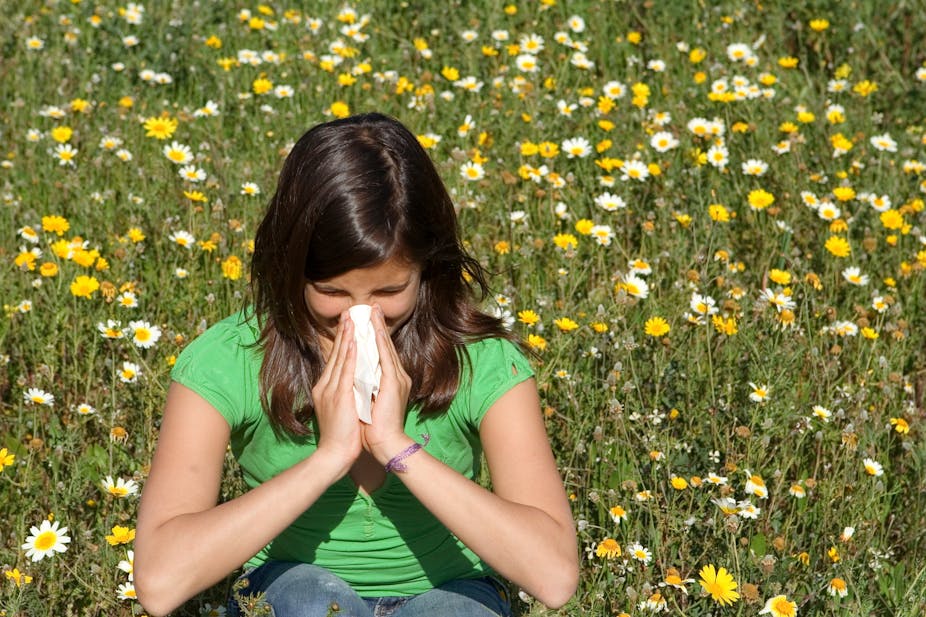The excitement of sunshine and warm weather that comes with the approaching summer is tempered for some by the sneezing, itchy eyes and congested airways that accompanies it.
Hay fever, or seasonal allergic rhinoconjunctivitis to give it its official name, is caused when our bodies produce allergic antibodies to the proteins in tree and grass pollens. The antibodies then sit in the immune cells we have on all surfaces of our bodies, in contact with the outside. When more pollen is inhaled, the proteins then cause these antibodies to burst and release histamine.
This is a normal defence system gone astray. Histamine causes the familiar itching, sneezing and running of the nose and sore eyes that make hay fever a misery. In the longer term, airways can become inflamed and blocked, causing permanent nasal stuffiness, snoring, lack of sleep and susceptibility to infections and sinusitis. The skin around the eyes can also become very swollen, making it difficult to see (or even walk) when symptoms are severe.
Pollens from birch, alder and hazel trees are the biggest culprits in the UK causing early spring symptoms. They appear from February until the end of May, then grass pollens from the end of May until the end of August, with June and July (Wimbledon fortnight!) typically being the worst months. So if you’re sensitive to both tree and grass pollens then inconvenience is guaranteed from February right through until August of any given year.
Hay fever, especially to non-sufferers, can sound like a trivial disease. But it can wipe out weeks of useful functioning in the summer, is the fifth most common cause of lack of sleep in the pollen months and is a proven cause of examination under-performance by afflicted individuals at school.
We don’t know why some people produce antibodies against pollen and others don’t, but it is now more common to produce them than not. This increase has been principally observed in developed countries, which has resulted in theories that this allergy epidemic has been driven by environmental changes: fewer infections in childhood, living away from environments such as farms, which seem to inhibit the development of allergies, and modern changes in diet and lifestyle (for example over-heated, poorly ventilated homes).
Year to year variance
Some years are worse for hay fever sufferers than others. This partly reflects the overall amount of pollen floating about, but also individual circumstances: for example, people living near coastlines are often better off because the prevailing winds tend to carry pollen away.
The amount of pollen produced in any year depends on the severity of the preceding winter: mild winters typically result in more pollen production. The weather during the pollen season also affects symptoms: wet summers with a lot of rain keep the pollen down. Long, dry summers prolong its mobility and abundance. The lightning in thunderstorms can break pollen grains into smaller particles which can lead to acute outbreaks of hay fever.
Patterns of development
The curious thing about hay fever is that it’s a disease that some people seem to grow out of, while others don’t – and scientists don’t yet understand why this is. Typically, children who are susceptible to hay fever may start off with eczema in childhood and then develop food allergies when they start to eat solid foods, then develop hay fever as school children, then asthma in their teens.
Sometimes these diseases fade away as the person grows up, but sometimes they persist. Sometimes they also develop for the first time later in life. It is not known why these problems sometimes go away, and curiously it is not because people stop producing the allergic antibodies.
Asthma links
Because of this development pattern, people with hay fever are at greater risk of developing asthma. Because the susceptible cells line the lower airways as well as the nose, patients with hay fever and asthma often find that their asthma is worse during the pollen months because histamine release in the airways causes them to constrict.
This “seasonal” or “pollen” asthma can be quite severe. When treating asthma it makes sense to treat any associated hay fever as well, since having a blocked nose all the time bypasses the nose’s natural filter function and allows more pollens and other irritants into the airways, which my make asthma more difficult to control. Nevertheless there is no good evidence that neglecting hay fever treatment “causes” asthma: the diseases are simply more likely to occur together.
Treatment
The first line of hay fever treatment is with anti-histamines to counteract the histamine your body produces. Over the counter ones like cetirizine and loratadine are effective and generally non-sedating, but must be taken regularly to be effective. They take about four or five days to reach effective levels in the circulation if taken once daily, so taking the odd one when the symptoms are really bad does not work half as well.
Steroid nasal sprays are also excellent for anything other than mild symptoms: when used regularly these drive the relevant cells from the lining of the nose and so abolish the release of histamine in the first place. They are safe and effective when taken every day, usually starting a few weeks before the pollen turns up.
Eye symptoms are the other big problem. Anti-histamine drops may increase the effect of tablets. But for those with persistently bad symptoms, immunotherapy (a series of injections or a course of under the tongue drops or tablets) can alleviate the disease better still.
Although there is not yet an absolute cure for hay fever, it can be managed so if you’re showing symptoms it’s worth seeking advice from your GP or an allergy specialist so that you can get out and enjoy the sunshine.

